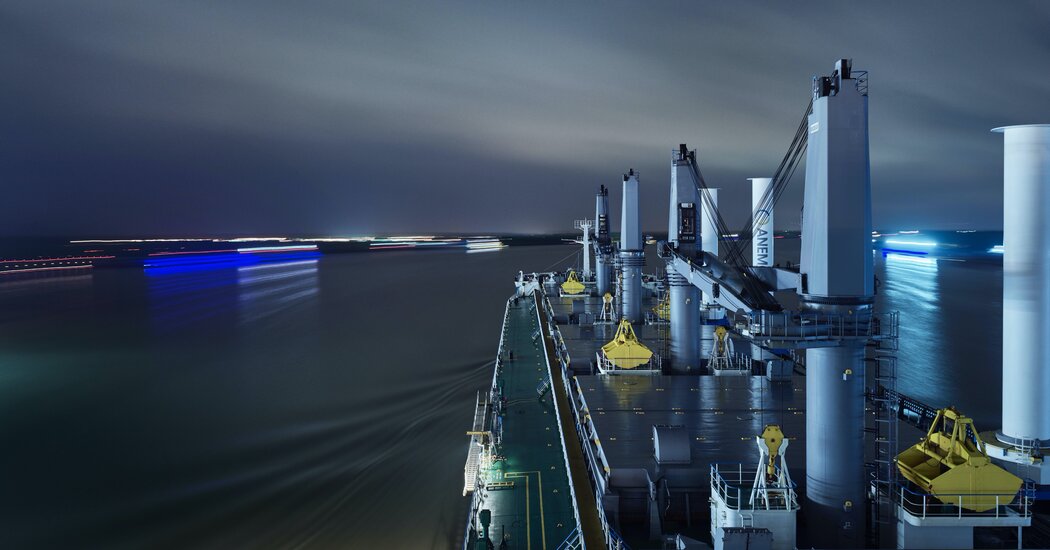
Schofield set up shop in a small room next to the Ben Ainslie Racing cafeteria, gathered a few of the engineers from the racing team and began designing, under the name BAR Technologies. The rigid sails they came up with, named WindWings, look like vertically mounted airplane wings, rising 120 feet or more, and consist of a steel frame wrapped in lightweight composite fibers hardened in resin. They’re meant to be installed on a ship in groups of three to five, rotating and changing shape to catch the wind so that the vessel can harness more free power from any given gust.
Schofield grew up on Mersea Island on England’s eastern coast, the son of a boatbuilder. His father made him his first sailboat — a single-masted green wooden dinghy named Polo — when he was 6. Schofield can’t remember a time before he was sailing Mersea’s creeks and estuaries, throwing barbecues with his friends on marshy banks; leaping into one another’s boats; slapping his homework shut on a Wednesday night to race, with as many as a hundred other kids in dinghies, during Mersea’s weekly regattas. It was on his boat that he learned to read the wind in the ripples on the water and catch a breeze as it slid along the curve of a cloud. He found sailing to be like a game of chess: You have to see far enough into the horizon to plot your route across the water from one gust of wind to the next.
Today’s seafarers no longer know their way around wind; conventional combustion-engine ships mostly take the shortest straight-line route to their destination. Part of an effective wind-propulsion system is software that can guide the ship onto routes that might not be the shortest — but, because of how the wind is moving, could be more fuel-efficient. During a windy stretch, a cargo vessel could turn off its engines and be propelled entirely by the wind. Modern wind propulsion, then, depends on teaching software, not seafarers, to gauge the best route.
By the time I visited Old Portsmouth, the Ben Ainslie Racing team had moved out of its building, largely leaving it to Schofield, now the company’s chief technology officer, and his workers. BAR Technologies commandeered the top floor, an oval open-plan room with near-360-degree views overlooking the harbor and the historic rowhouses. Schofield’s team had grown to 25, with a new hire coming in nearly every week. Mechanical and systems engineers, computational-fluid-dynamics analysts and software developers worked in a quiet hush in front of wide monitors.
Bright yellow masking tape was arranged in loops on the floor — the central section 33 feet wide, with two sections 16 feet wide on either side — running nearly half the length of the office. These were outlines, at full scale, of BAR Technologies’ WindWings. The sails are designed to be fitted onto tankers and dry-bulk carriers, which transport unpackaged goods such as grain or coal. Schofield looked up the building’s measurements and worked out that the office floor was 100 feet high, meaning the WindWings would be 24 feet higher. I looked up, trying to imagine a sail rising to that height.
When Schofield first took on the task of making a sail fit for cargo vessels, he thought it would be easy: sort of like a yacht sail, but bigger. But sails for a cargo ship need to be optimized for factors beyond just speed. There were ports to consider, seafarers, shipowners, manufacturers, regulations, the placement of hatches, bird collisions, the not-uncommon prospect of a 36-foot wave breaking across the deck in the middle of a storm.
The design they ended up with, the WindWing, can be installed as a retrofit on existing cargo vessels or fitted onto newly built ships. The sail is designed to pivot automatically, using sensors to gauge the speed and direction of the wind, to catch it and to make sure the ship keeps moving forward. During a storm, or when the wind is blowing too strongly, the sails would automatically turn off, whipping in the wind without harnessing it. To allow the ship to go under a bridge, or while it is at port, the wings would fold into themselves, then lower, flat, onto the surface of the deck — a 15-minute process — so they would be clear of the cargo hatches, cranes and railings of the ship.
Average Rating